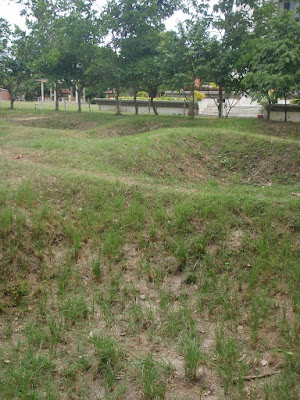Because it's impossible to talk about Cambodia without talking about the Khmer Rouge, here is a brief summary of those bloody years:
Incredibly recently (1975-1979), Cambodia was torn apart by the Khmer Rouge. Starting in 1975, the Communist Party of Kampuchea ruled the country under the leadership of a man who called himself Pol Pot. His aim was to essentially purge the entire country of capitalism, and create an agrarian-based Communist society. Everyone living in urban cities were deported to the countryside in forced marches, where all citizens (men, women, and children) were submitted to forced labor. As part of the "master plan," Pol Pot attempted to make the Kingdom of Cambodia a completely self-sufficient country--even when it came to medicines--and as a result thousands died from curable diseases under the Khmer Rouge. Hundreds of thousands more died in waves of murder, torture, and starvation, aimed particularly at the educated and intellectual elite (Pol Pot saw education as a threat to a truly agrarian society). When all was said and done, it is estimated that 2.2 million Cambodians (out of a total population of 7 million) died under the Khmer Rouge. It was a rampant genocide, one which the rest of the world remained oblivious to until it was much too late. Eventually, Vietnamese military intervention (December of 1978) ended the genocide, but the effects of the Khmer Rouge are still felt today. Some of the most notorious leaders of the party were never brought to trial. Cambodians still suffer today, with huge amounts of unemployment and poverty. We were told by a local man that the current government runs off of corruption and theft. Much of the monetary help sent in from other countries never makes its way to the Cambodian people. Instead, the leaders of the government drive through Cambodia slums in their Rolls Royces, which they park in their giant gated mansions. Though this country has overcome a very bleak past, a bright future is not guaranteed.
Our first full day in Phnom Phen found us on a tour of some of the most important--albeit depressing--sights in the city: the S-21 prison museum, and The Killing Fields. The S-21 prison was a former high school that was converted to a place of torture and execution controlled by the Khmer Rouge. This prison existed for one reason: almost immediately after Pol Pot's rise to power, he became paranoid that he would be overthrown, and decided to hunt down all those whom he perceived as a threat. This included intellectuals, former government officials, and even Pol Pot's own Men. Even people that wore glasses were sometimes shot dead because they 'looked smart'. The suspects were brought to S-21, then tortured and killed. In 1978 alone, over 5,000 prisoners passed through S-21, and many of their pictures hauntingly stare at you as you walk the rooms where they were once held.
The rules of the prison.
(Click on the picture to enlarge.)
One of many rooms where the Khmer Rouge interrogated (read: brutally tortured and eventually killed) their prisoners.
When the Khmer Rouge was finally overthrown by the Vietnamese, the bodies of 14 prisoners were found decaying in torture rooms, one of which was a woman. These are their graves.
One of the many horrific methods of torture used by the prison guards. They would hang prisoners upside down by their arms until they passed out, at which point guards would dunk the prisoners heads into these jugs filled with putrid water. This jolted them awake so the guards could continue questioning.
The Killing Fields, a blunt but appropriate name, is the site upon which nearly 17,000 men, women, and children were executed and then buried in mass graves during the Khmer Rouge. A monument, in which the skulls and bones of 5,000 of these victims are housed, is a very graphic reminder of the atrocities committed by the Khmer Rouge.
Monument erected in remembrance
of the thousands of people killed here.
of the thousands of people killed here.
The skulls of hundreds of 15-25 year old victims.
Excavated mass grave sites.
The mass grave next to this tree contained 400 women and children.
On our second day in Phnom Penh, we decided to see the happy side of the city. We started the day off at the "Russian Market", which, (to Preston's horror) held one two many silver shops for Jessica to resist, as well as some tasty/questionable local foods.
From the market, our tuk-tuk driver took us to the National Museum, which apart from being one of the most amazing buildings we've seen in Asia, held some really impressive Khmer Empire artifacts.
(Note:the Khmer Empire was the most powerful and prolific ancient civilization of SE Asia--the Khmer Rouge takes it's name from this, not the other way around.)
The National Museum.
After the museum, we headed to the King's Palace and Silver Pagoda, which unfortunately we weren't allowed into because Jessica didn't have sleeves. (In her defense, she brought a shawl to cover her shoulders, but for some unknown reason they have a "no shawl, only sleeves" policy.) A little disappointed, but okay with it nonetheless, we decided to just take a walk along the Mekong River back to our guesthouse.
We came across the American flag on our walk! Nice to find a little piece of home every once in a while.
The Independence Monument to commemerate Cambodia's emancipation from French rule in 1953.
Cambodian flags.
Next stop, Siem Reap, Cambodia and the famed temples of Angkor!
















No comments:
Post a Comment